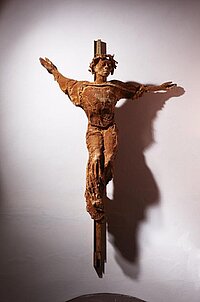Neubaukirche
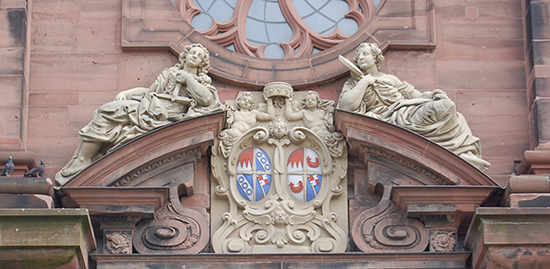
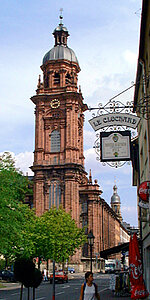
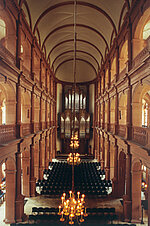
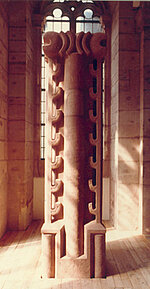
Neubaukirche
A Church turned Festive Assembly Hall
In 1582, the University of Würzburg founder, Catholic Prince-Bishop Julius Echter von Mespelbrunn, decided that the university should also have its own church. Today, this church no longer serves as a house of prayer but as a location for university functions, concerts, and conferences. The name Neubaukirche (Newly Built Church) is said to be derived from the fact that in the 16th century, the university’s church was the new build in the city of Würzburg.
The history of the church starts in 1583, the year after the university was founded. In that year, the Prince-Bishop had Georg Robin – an architect from Mainz who, in 1576, had already planned the hospital Juliusspital for the Prince-Bishop – build the church. The east, north and west wings of Echter University had already been erected when construction of the church began in 1586. Two years later, Echter ordained that a tomb should be built for himself within the church. He wanted his heart to be buried there.
On 8 September 1591, the university church was solemnly consecrated, and in the following year, the construction of the university and the church was completed.
Swedish invasion halts restoration
Construction was completed very quickly – too quickly, it turned out. Soon afterwards, substantial work was required to conserve the structure. In 1626, the vault had to be dismantled and the roof of the steeple had to be removed. Restoration work was not yet in full swing when it was halted in 1631 by the Swedish invasion. Following the invasion, the church was left without a roof and a vault, and fell victim to the elements for almost 70 years.
In 1696, Prince-Bishop Johann Gottfried von Guttenberg had the church restored by artist Antonio Petrini. A new vault and roof were put in place, three more buttresses were added to the existing six on the southern side, and the second floor of the steeple as well as the octagon above it were built. Once these measures were completed, the steeple had received an appearance that remained largely unchanged to this day.
Altars and pulpit sold
In the 18th century, Prince-Bishop Johann Philipp Greiffenclau ordained that the church should be fitted with new interiors. They did not remain in place for long; most of them were lost at the beginning of the 19th century when, in the course of secularization, the building was desecrated and was used as storage for files and books. Even the baroque high altar as well as the side-altars and pulpit were dismantled and sold.
In 1851, the church stopped serving as a storage facility: an organ was added and from 1867 onwards, services resumed. On the occasion of the university’s 300-year anniversary in 1882, the decision was made to redesign the interior of the church. By 1890, the church had received several colorful adornments from renowned artists of the time, including frescos by Munich painter Barthelme.
Unfortunately, the splendor did not last very long either. The church’s grandeur characterized the cityscape for just over 50 years only. During the bombing raid on the night of 16 March 1945, the Neubaukirche met the same fate as the rest of the city of Würzburg – complete destruction. The church and the largest part of the university library, which had been housed in the Old University, were almost completely ruined.
Clearing away the debris
It took almost one year – until late 1946 – to clear away the debris: Once that was done, the university’s first priority was to resume regular teaching operations. The church and steeple were fitted with a makeshift roof in 1949, which was destroyed in a storm in the mid-1950s. At that time, the fate of the church was uncertain. It quickly became clear that the university would not be able to bear the cost of reconstruction on its own. For this reason, only the most important safeguard measures were taken. They were completed by 1957.
In the late 1960s, Professor Werner Uhlmann, then Rector of the university, decided to take the matter into his own hands and launched a series of fundraisers in cooperation with the local press. During one of the first of these events, engravings by Högler and Salver were sold for 50 Deutschmarks each. This event inspired joint action from artists, entrepreneurs, scientists, student societies, businesses, associations, journalists, and numerous citizens of Würzburg and its surrounding communities. Together, they organized open days, concerts, exhibitions, and plenty of other events, sparing no opportunity to raise as many funds as possible for the reconstruction of the church. The Verschönerungsverein Würzburg, for example, sponsored the coining of gold and silver medals which were sold, with proceeds going to the reconstruction of the Neubaukirche.
In 1970, the Senate passed a resolution on the reconstruction of the church and decided that, once reconstruction was completed, the church was to be used as a venue for concerts, functions, assemblies, exhibitions, etc. On 28 September 1977, the topping-out ceremony for the steeple of the Neubaukirche took place.
Five years later, in 1982, the university celebrated the 400-year anniversary of its founding by Julius Echter. On this occasion, the heart of the founder of the university – having survived the bombing raid in March 1945 in a tin case – was solemnly entombed in a monument within the church on 13 September. On 7 November 1985, the church was finally reopened.
Illumination and carillon
Today, the church is in a better state than ever before. In 1986, shortly after the completion of the Neubaukirche, a Schuke organ – the second largest organ in the city, surpassed in size only by the organ in Würzburg Cathedral – was fitted. In 2003, the steeple of the Neubaukirche was included in the list of major buildings in Würzburg to be illuminated at nightfall.
At the initiative of Bruno Forster, then Chancellor of the university, the steeple was fitted with a carillon in 2005, making the University of Würzburg one of the few universities in Europe to have such an instrument. The acquisition of the carillon, like the reconstruction of the church, was financed mainly through the donations of numerous sponsors.
More information
“Die Würzburger Universitätskirche 1583-1973. Zur Geschichte des Baues und seiner Ausstattung”, Reinhardt Helm, in: “Quellen und Beiträge zur Geschichte der Universität Würzburg”, Bd. 5, Neustadt a.d. Aisch 1976
Works of art in the Neubaukirche
Since 10 December 2010, two sculptures have adorned the front of the two wings of the church. These sculptures – each 140 centimeters in height – depict Christ and Saint Catherine and were made by painter and sculptor Karlheinz Oswald. Their surface has a special patina obtained by wax, gypsum and oxidation.
Christ and Saint Catherine were selected as “symbols for the original use of the Neubaukirche as the church of the university re-founded by Prince-Bishop Julius Echter, and its current use as a festive assembly hall of Alma Julia,” says Capitular Dr. Jürgen Lenssen, Kunstreferent of the Diocese of Würzburg.
Fürst Albrecht zu Castell-Castell, former Chairman of the Universitätsbund, had suggested that the Neubaukirche be adorned with works of art. The university’s Board of Governors headed by President Alfred Forchel approved this suggestion and implemented it in cooperation with the Kunstreferat of the Diocese of Würzburg. The acquisition was financed partly with funds from the Diocese and partly through donations raised after a joint appeal by Forchel and Professor Dieter Salch, Honorary Senator of the university.






